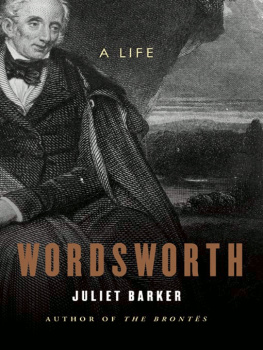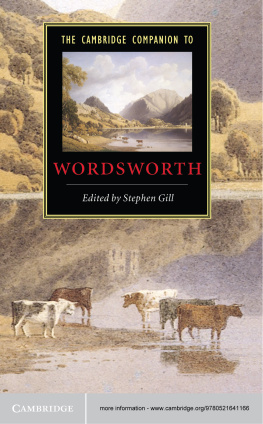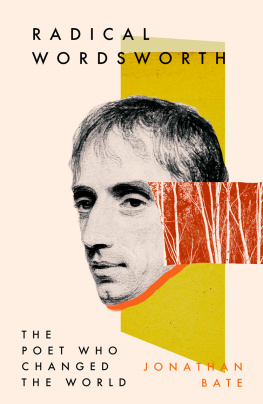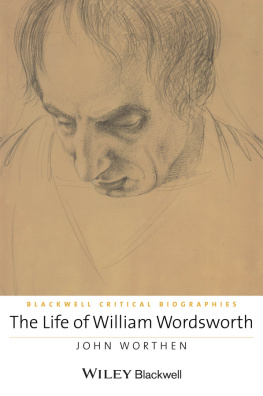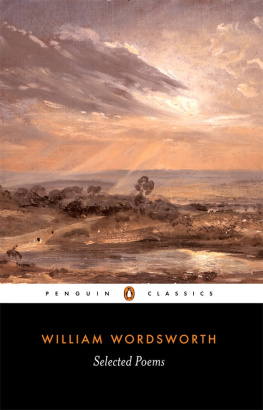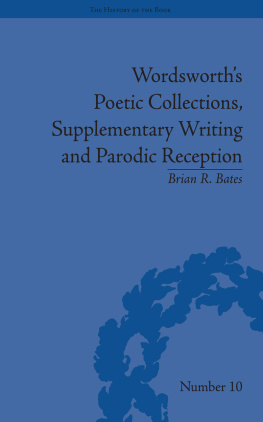Wordsworths Poetry, 18151845
Wordsworths Poetry, 18151845
Tim Fulford

A volume in the Haney Foundation Series, established in 1961 with the generous support of Dr. John Louis Haney.
Copyright 2019 University of Pennsylvania Press
All rights reserved. Except for brief quotations used for purposes of review or scholarly citation, none of this book may be reproduced in any form by any means without written permission from the publisher.
Published by
University of Pennsylvania Press
Philadelphia, Pennsylvania 19104-4112
www.upenn.edu/pennpress
Printed in the United States of America
on acid-free paper
10 9 8 7 6 5 4 3 2 1
A Cataloging-in-Publication record is available from the Library of Congress
ISBN 978-0-8122-5081-7
Contents
1807 | William Wordsworth, Poems, in Two Volumes (London: Longman, 1807) |
1815 | Poems by William Wordsworth: Including Lyrical Ballads, and the Miscellaneous Pieces of the Author. With Additional Poems, a New Preface, and a Supplementary Essay, 2 vols. (London: Longman, 1815) |
1827 | The Poetical Works of William Wordsworth, 5 vols. (London: Longman, 1827) |
1845 | The Poems of William Wordsworth, D.C.L (London: Moxon, 1845) |
BL | S. T. Coleridge, Biographia Literaria, ed. James Engell and W. Jackson Bate, 2 vols. (Princeton, NJ: Princeton UP, 1983) |
BLJ | Byrons Letters and Journals, ed. Leslie A. Marchand, 12 vols. (London: Murray, 197782) |
BPW | Byron, The Complete Poetical Works, ed. Jerome J. McGann and Barry Weller, 7 vols. (Oxford: Oxford UP, 199193) |
CN | Collected Notebooks of Samuel Taylor Coleridge, ed. Kathleen Coburn, 5 vols. (Princeton, NJ: Princeton UP, 19572002) |
CPW | S. T. Coleridge, Poetical Works, ed. J. C. C. Mays, 6 vols. (Princeton, NJ: Princeton UP, 2001) |
Duddon | Wordsworth, The River Duddon, a Series of Sonnets: Vaudracour and Julia: and Other Poems. To which is annexed, a topographical description of the country of the Lakes, in the North of England (London: Longman, 1820) |
Excursion | Wordsworth, The Excursion, ed. Sally Bushell, James A. Butler and Michael C. Jaye (Ithaca, NY: Cornell UP, 2007) |
EY | The Letters of William and Dorothy Wordsworth: The Early Years, 17871805, ed. Ernest De Selincourt, rev. Chester L. Shaver (Oxford: Oxford UP, 1967) |
Last Poems | Wordsworth, Last Poems, 18211850, ed. Jared Curtis (Ithaca, NY: Cornell UP, 1999) |
LB | Wordsworth, Lyrical Ballads and Other Poems, 17971800, ed. James Butler and Karen Green (Ithaca, NY: Cornell UP, 1992) |
LY | The Letters of William and Dorothy Wordsworth: The Later Years, ed. E. de Selincourt, rev. Alan G. Hill, 4 vols. (Oxford: Oxford UP, 197888) |
MY | The Letters of William and Dorothy Wordsworth: The Middle Years, 180620, ed. E. de Selincourt, rev. Mary Moorman and Alan G. Hill, 2 vols. (Oxford: Oxford UP, 196970) |
Prose Works | The Prose Works of William Wordsworth, ed. W. J. B. Owen and Jane Worthington Smyser, 3 vols. (Oxford: Oxford UP, 1974) |
Shorter Poems | Wordsworth, Shorter Poems, 18071820, ed. Carl H. Ketcham (Ithaca, NY: Cornell UP, 1989) |
Sonnets | Wordsworth, Sonnet Series and Itinerary Poems, 18201845, ed. Geoffrey Jackson (Ithaca, NY: Cornell UP, 2004) |
TT | S. T. Coleridge, Table Talk, ed. Carl Woodring, 2 vols. (Princeton, NJ: Princeton UP, 1990) |
YR | Wordsworth, Yarrow Revisited, and Other Poems (London: Moxon, 1835) |
For the best part of a century, the poems that Wordsworth wrote over the last thirty years of his career have been neglected. This was not in the case in his lifetime or in the post-1850 Victorian era, when works such as the River Duddon collection of 1820 and the Yarrow Revisited volume of 1835 attracted good reviews and healthy sales. Wordsworth was valued then not principally for the blank-verse Greater Romantic Lyrics he wrote between 1798 and 1810, but for odes, sonnets, inscriptions, and memorials (a name he gave to poems that aimed in an impersonal voice to bear witness to history as embodied in monuments, ruins, and relics). Indeed, before 1820 the nature meditations and rustic lyrical ballads that led Keats to refer to Wordsworths egotistical sublime were commonly viewed as ridiculous exercises in self-worshipthe poems of an eccentric who absurdly overvalued the observations of his mean, puerile, and namby pamby mind.
By the 1960s and 70s, the picture had been reversed. Generations of professional literary critics had held up the earlier work as the apogee of lyric poetry; Wordsworth had become the high priest of what, in a largely post-religious age, was taken to be Romanticisms chief contribution to literature and cultureits ability to transcend both the mundane, industrialized world and the commodified self which that world produced by discovering, via nature, the freedom of the individual imagination (or at least by exhibiting the heroism of the quest). The Cornell Wordsworththat great editorial enterprise of twentieth-century academewas the ultimate expression of this critical consensus. It devoted tome after tome to poems of the so-called Great Decade, producing no less than three editions of The Prelude, but then grouped the works written between 1820 and 1845 into a volume entitled Last Poems, as if the verse of Wordsworths early fifties and late seventies was all of a piecethe final sputterings of a career at its end.
As Wordsworths oeuvre was divided and the status of the earlier work rose, that of the later work fell. In 1923 H. W. Garrod, reflecting Matthew Arnolds preference for the earlier poems, The Excursion (1814) became, in the wake of such views, the last poem worth considering in detailthough even it was chiefly summoned to evidence Wordsworths decline since the 1805 Prelude.
Nature poetry and prophetic vision would no longer be constitutive of Romanticism: Wordsworths indifference to newly popular genres such as the historical novel, womens poetry, and the magazine essay made his verse again seem to many, as it had to reviewers before 1820, self-secluding and marginal.
The New Historicist critique of Wordsworth, and of Wordsworth criticism, had two effects. It provoked a reaction from critics who argued that it misunderstood the poets key relationships to nature and imagination: the best of these critics set about providing nuanced re-readings of the verse. No longer even read, the post-1810 (or even post-1807) work became an omission passed down the critical generations in graduate school.
There were exceptions to the general neglect. One of the first to look again at the post-1814 poetry was, somewhat surprisingly in view of his earlier opinions, Geoffrey Hartman. In Blessing the Torrent: On Wordsworths Later Style (1978), he discussed an 1824 sonnet, and in Words, Wish, Worth: Wordsworth (1979), he examined the 1816 poem A little These seminal essays renewed Hartmans emphasis on a Wordsworth engaged in a struggle to derive a vatic voice from a natural world encountered as sounds and traces. But Hartman now showed that the terms of the struggle were not repeated, in diminished form, but altered by the anxieties attendant upon agethe responsibilities of fatherhood, fear of incapacity, the weight of earlier work to be lived up to. Wordsworths profound explorations of the poets task and searching meditations on the sources of power were no longer confined to the Great Decade: he had an afterlife that was not dismissible as decline.
Next page

